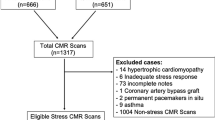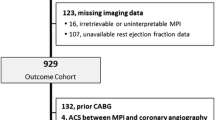Abstract
Background
The significance of post-stress reduction in left ventricular ejection fraction (LVEF) in patients with normal perfusion on adenosine stress/rest imaging remains controversial.
Methods
Consecutive patients who underwent 2-day adenosine gated stress/rest 99mTc-sestamibi imaging and had normal perfusion were analyzed. LVEF was quantified at rest and 1 hour post-adenosine. Patients were followed up for hard (cardiac death or nonfatal MI) and soft (coronary revascularization or congestive heart failure) cardiac events for 24.1 ± 11.0 months.
Results
Of 560 patients included in the study, 135 (24.1%) had a post-stress reduction in LVEF of ≥ 5%. Rest LVEF (P < 0.001), known history of CAD (P = 0.01) and transient ischemic dilatation ratio (P = 0.02) were independent predictors of LVEF reduction. Event-free survivals were similar in patients with and without ≥ 5% LVEF reduction (P = 0.8). The unadjusted hazard ratio (95% CI) for cardiac events for ≥ 5% LVEF reduction was 1.09 (0.55-2.15), P = 0.81, while the hazard ratio adjusted for known history of CAD, smoking, post-stress LVEF and peak heart rate was 0.87 (0.44-1.75), P = 0.71.
Conclusions
Significant post-adenosine reduction in LVEF occurs in about one-fourth of patients with normal perfusion but does not confer adverse prognosis compared with patients without such reduction.



Similar content being viewed by others
Abbreviations
- EF:
-
Ejection fraction
- LV:
-
Left ventricular
- MBq:
-
Megabecquerel
- mCi:
-
Millicurie
- SPECT:
-
Single photon emission computerized tomography
- SSS:
-
Summed stress score
- SRS:
-
Summed rest score
- SDS:
-
Summed difference score
- Tc-99m:
-
Technetium-99m
- MI:
-
Myocardial infarction
References
Dorbala S, Ananthasubramaniam K, Armstrong IS, Chareonthaitawee P, DePuey EG, Einstein AJ, et al. Single photon emission computed tomography (SPECT) myocardial perfusion imaging guidelines: Instrumentation, acquisition, processing, and interpretation. J Nucl Cardiol. 2018;25:1784-846.
Sharir T, Bacher-Stier C, Dhar S, Lewin HC, Miranda R, Friedman JD, et al. Identification of severe and extensive coronary artery disease by postexercise regional wall motion abnormalities in Tc-99m sestamibi gated single-photon emission computed tomography. Am J Cardiol. 2000;86:1171-5.
Paul AK, Hasegawa S, Yoshioka J, Mu X, Maruyama K, Kusuoka H, et al. Characteristics of regional myocardial stunning after exercise in gated myocardial SPECT. J Nucl Cardiol. 2002;9:388-94.
Emmett L, Iwanochko RM, Freeman MR, Barolet A, Lee DS, Husain M. Reversible regional wall motion abnormalities on exercise technetium-99m-gated cardiac single photon emission computed tomography predict high-grade angiographic stenoses. J Am Coll Cardiol. 2002;39:991-8.
Druz RS, Akinboboye OA, Grimson R, Nichols KJ, Reichek N. Postischemic stunning after adenosine vasodilator stress. J Nucl Cardiol. 2004;11:534-41.
Toba M, Kumita S, Cho K, Ibuki C, Kumazaki T, Takano T. Usefulness of gated myocardial perfusion SPECT imaging soon after exercise to identify postexercise stunning in patients with single-vessel coronary artery disease. J Nucl Cardiol. 2004;11:697-703.
Hida S, Chikamori T, Tanaka H, Usui Y, Igarashi Y, Nagao T, et al. Diagnostic value of left ventricular function after stress and at rest in the detection of multivessel coronary artery disease as assessed by electrocardiogram-gated SPECT. J Nucl Cardiol. 2007;14:68-74.
Dona M, Massi L, Settimo L, Bartolini M, Gianni G, Pupi A, et al. Prognostic implications of post-stress ejection fraction decrease detected by gated SPECT in the absence of stress-induced perfusion abnormalities. Eur J Nucl Med Mol Imaging. 2011;38:485-90.
Ferro A, Petretta M, Acampa W, Fiumara G, Daniele S, Petretta MP, et al. Post-stress left ventricular ejection fraction drop in patients with diabetes: A gated myocardial perfusion imaging study. BMC Cardiovasc Disord. 2013;13:99.
Johnson LL, Verdesca SA, Aude WY, Xavier RC, Nott LT, Campanella MW, et al. Postischemic stunning can affect left ventricular ejection fraction and regional wall motion on post-stress gated sestamibi tomograms. J Am Coll Cardiol. 1997;30:1641-8.
Tanaka H, Chikamori T, Hida S, Usui Y, Harafuji K, Igarashi Y, et al. Comparison of post-exercise and post-vasodilator stress myocardial stunning as assessed by electrocardiogram-gated single-photon emission computed tomography. Circ J. 2005;69:1338-45.
Demir H, Tan YZ, Isgoren S, Gorur GD, Kozdag G, Ural E, et al. Comparison of exercise and pharmacological stress gated SPECT in detecting transient left ventricular dysfunction. Ann Nucl Med. 2008;22:403-9.
Chun KA, Cho IH. Adenosine-induced long-standing postischemic left ventricular dysfunction evaluated with gated SPECT. Clin Nucl Med. 2005;30:18-22.
Ben-Haim S, Gips S, Merdler A, Front A, Tamir A. Myocardial stunning demonstrated with rest and post-stress measurements of left ventricular function using dual-isotope gated myocardial perfusion SPECT. Nucl Med Commun. 2004;25:657-63.
Van Tosh A, Votaw JR, Reichek N, Palestro CJ, Nichols KJ. The relationship between ischemia-induced left ventricular dysfunction, coronary flow reserve, and coronary steal on regadenoson stress-gated (82)Rb PET myocardial perfusion imaging. J Nucl Cardiol. 2013;20:1060-8.
Bonow RO. Gated myocardial perfusion imaging for measuring left ventricular function. J Am Coll Cardiol. 1997;30:1649-50.
Dorbala S, Vangala D, Sampson U, Limaye A, Kwong R, Di Carli MF. Value of vasodilator left ventricular ejection fraction reserve in evaluating the magnitude of myocardium at risk and the extent of angiographic coronary artery disease: a 82Rb PET/CT study. J Nucl Med. 2007;48:349-58.
Braunwald E, Kloner RA. The stunned myocardium: prolonged, postischemic ventricular dysfunction. Circulation. 1982;66:1146-9.
Gerber BL, Wijns W, Vanoverschelde JL, Heyndrickx GR, De Bruyne B, Bartunek J, et al. Myocardial perfusion and oxygen consumption in reperfused noninfarcted dysfunctional myocardium after unstable angina: direct evidence for myocardial stunning in humans. J Am Coll Cardiol. 1999;34:1939-46.
Barnes E, Hall RJ, Dutka DP, Camici PG. Absolute blood flow and oxygen consumption in stunned myocardium in patients with coronary artery disease. J Am Coll Cardiol. 2002;39:420-7.
Barnes E, Dutka DP, Khan M, Camici PG, Hall RJ. Effect of repeated episodes of reversible myocardial ischemia on myocardial blood flow and function in humans. Am J Physiol Heart Circ Physiol. 2002;282:H1603-8.
Benz DC, Gaemperli O. The right timing for post-ischemic stunning. J Nucl Cardiol. 2017;24:1302-4.
Gomez J, Golzar Y, Fughhi I, Olusanya A, Doukky R. The significance of post-stress decrease in left ventricular ejection fraction in patients undergoing regadenoson stress gated SPECT myocardial perfusion imaging. J Nucl Cardiol. 2018;25:1313-23.
Sharir T, Germano G, Waechter PB, Kavanagh PB, Areeda JS, Gerlach J, et al. A new algorithm for the quantitation of myocardial perfusion SPECT. II: validation and diagnostic yield. J Nucl Med. 2000;41:720-7.
Thygesen K, Alpert JS, Jaffe AS, Simoons ML, Chaitman BR, White HD, the Writing Group on behalf of the Joint ESC/ACCF/AHA/WHF Task Force for the Universal Definition of Myocardial Infarction. Third universal definition of myocardial infarction. Circulation. 2012;126:2020-35.
Hage FG, Perry G, Heo J, Iskandrian AE. Blunting of the heart rate response to adenosine andregadenoson in relation to hyperglycemia and the metabolic syndrome. Am J Cardiol. 2010;105:839-43.
Mente S, Kuhn M. The use of the R language for medicinal chemistry applications. Curr Top Med Chem. 2012;12:1957-64.
Brinkman N, Dibbets-Schneider P, Scholte AJ, Stokkel MP. Myocardial perfusion scintigraphy with adenosine: Does it impair the left ventricular ejection fraction obtained with gated SPECT? Clin Nucl Med. 2008;33:89-93.
Mustonen JN, Uusitupa MI, Tahvanainen K, Talwar S, Laakso M, Lansimies E, et al. Impaired left ventricular systolic function during exercise in middle-aged insulin-dependent and noninsulin-dependent diabetic subjects without clinically evident cardiovascular disease. Am J Cardiol. 1988;62:1273-9.
Prior JO, Quinones MJ, Hernandez-Pampaloni M, Facta AD, Schindler TH, Sayre JW, et al. Coronary circulatory dysfunction in insulin resistance, impaired glucose tolerance, and type 2 diabetes mellitus. Circulation. 2005;111:2291-8.
Storto G, Pellegrino T, Sorrentino AR, Luongo L, Petretta M, Cuocolo A. Estimation of coronary flow reserve by sestamibi imaging in type 2 diabetic patients with normal coronary arteries. J Nucl Cardiol. 2007;14:194-9.
Marciano C, Galderisi M, Gargiulo P, Acampa W, D’Amore C, Esposito R, et al. Effects of type 2 diabetes mellitus on coronary microvascular function and myocardial perfusion in patients without obstructive coronary artery disease. Eur J Nucl Med Mol Imaging. 2012;39:1199-206.
Marcassa C, Giubbini R, Acampa W, Cittanti C, Djepaxhija O, Gimelli A, et al. Impact of imaging protocol on left ventricular ejection fraction using gated-SPECT myocardial perfusion imaging. J Nucl Cardiol. 2017;24:1292-301.
Supino PG, Borer JS, Herrold EM, Hochreiter C. Prognostication in 3-vessel coronary artery disease based on left ventricular ejection fraction during exercise: Influence of coronary artery bypass grafting. Circulation. 1999;100:924-32.
Disclosure
The authors have no conflicts of interest to report.
Author information
Authors and Affiliations
Contributions
OSO, MEJ: contributed to the conception and design of the study, analysis and interpretation of data, drafting and final approval of the manuscript. AA, BB, OA, MA, HZ, OA, MAJ, SJ, HJ, OA, OA: actively involved in collecting and analyzing data and approved the of final manuscript.
Corresponding author
Additional information
Publisher's Note
Springer Nature remains neutral with regard to jurisdictional claims in published maps and institutional affiliations.
The authors of this article have provided a PowerPoint file, available for download at SpringerLink, which summarises the contents of the paper and is free for re-use at meetings and presentations. Search for the article DOI on SpringerLink.com.
Funding
No funding source was used to support this work.
Electronic supplementary material
Below is the link to the electronic supplementary material.
Rights and permissions
About this article
Cite this article
Obeidat, O.S., Alhouri, A., Baniissa, B. et al. Prognostic significance of post-stress reduction in left ventricular ejection fraction with adenosine stress in Jordanian patients with normal myocardial perfusion. J. Nucl. Cardiol. 27, 1596–1606 (2020). https://doi.org/10.1007/s12350-019-01725-9
Received:
Accepted:
Published:
Issue Date:
DOI: https://doi.org/10.1007/s12350-019-01725-9




